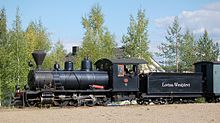Narrow-gauge railways in Finland

The vast majority of Finnish narrow-gauge railways were owned and operated by private companies. There are only a few instances where narrow-gauge railways were in direct connection with each other, and those interchanges did not last for long. The railways never formed a regional rail traffic network, but were only focused on maintaining connections between the national Russian-gauge railway network and the off-line industries.
Some railways were closed due to competition from the roads, others were converted to 1,524 mm (5 ft) Russian gauge.
Common carriers
- The Lovisa–Wesijärvi railway (1900–1960) that operated an 80 km (50 mi) line between Lahti and Loviisa.
- The Hyvinkää–Karkkila railway that operated a 46 km (29 mi) line
- The Jokioinen Railway that operated a 23 km (14.3 mi) line until 1974, being the last common-carrier narrow-gauge railway in Finland.
Other lines were notably shorter. The common gauges were 600 mm (1 ft 11+5⁄8 in) and 750 mm (2 ft 5+1⁄2 in), with a few railways built with 785 mm (2 ft 6+29⁄32 in) and 1,000 mm (3 ft 3+3⁄8 in) gauges.
Tourist and heritage lines
Narrow-gauge tourist and heritage lines of 600 mm (1 ft 11+5⁄8 in) gauge and 750 mm (2 ft 5+1⁄2 in) narrow gauge still operate.[1]
- Jokioinen Museum Railway, 750 mm (2 ft 5+1⁄2 in), 14 km, Jokioinen–Minkio–Humpilla.
- Nykarleby Jernväg, 600 mm (1 ft 11+5⁄8 in), 2 km.
- Tankavaara Kultakylä, 600 mm (1 ft 11+5⁄8 in), opened in 1997.
- Outokummun Kaivosrautatie, 750 mm (2 ft 5+1⁄2 in), 1.15 km, former copper mine.
Other
- Rokua railway, 900 mm (2 ft 11+7⁄16 in), 3.3 km (2.1 mi), line connecting a hotel with a fitness center
References
- ^ of preserved narrow gauge railways in Finland Archived 2014-02-22 at the Wayback Machine A visitors guide to Nordic (Scandinavian) narrow gauge railways
